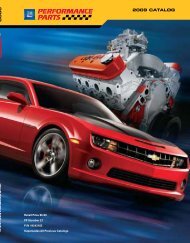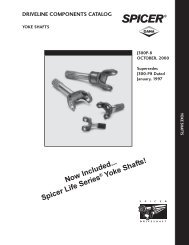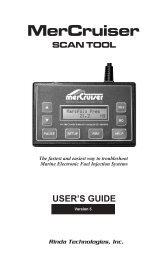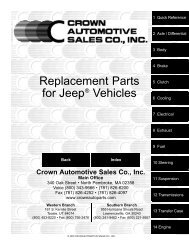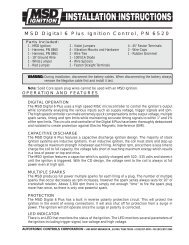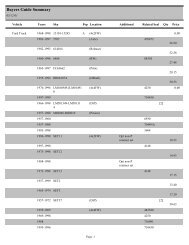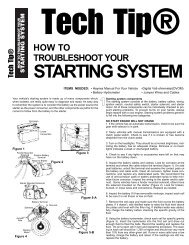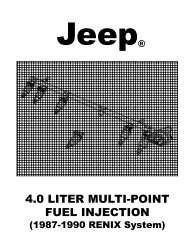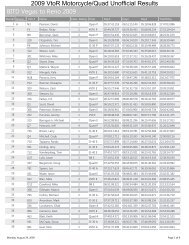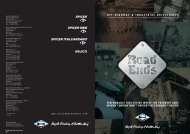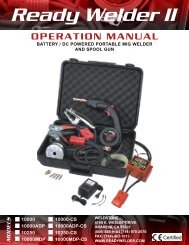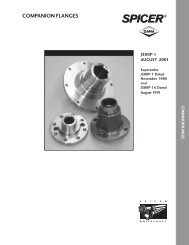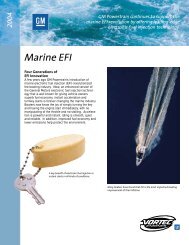Ball and Roller Bearings - Ntn-snr.com
Ball and Roller Bearings - Ntn-snr.com
Ball and Roller Bearings - Ntn-snr.com
You also want an ePaper? Increase the reach of your titles
YUMPU automatically turns print PDFs into web optimized ePapers that Google loves.
Load Rating <strong>and</strong> Life<br />
3. Load Rating <strong>and</strong> Life<br />
3.1 Bearing life<br />
Even in bearings operating under normal conditions, the<br />
surfaces of the raceway <strong>and</strong> rolling elements are<br />
constantly being subjected to repeated <strong>com</strong>pressive<br />
stresses which causes flaking of these surfaces to occur.<br />
This flaking is due to material fatigue <strong>and</strong> will eventually<br />
cause the bearings to fail. The effective life of a bearing<br />
is usually defined in terms of the total number of<br />
revolutions a bearing can undergo before flaking of either<br />
the raceway surface or the rolling element surfaces<br />
occurs.<br />
Other causes of bearing failure are often attributed to<br />
problems such as seizing, abrasions, cracking, chipping,<br />
gnawing, rust, etc. However, these so called "causes" of<br />
bearing failure are usually themselves caused by<br />
improper installation, insufficient or improper lubrication,<br />
faulty sealing or inaccurate bearing selection. Since the<br />
above mentioned "causes" of bearing failure can be<br />
avoided by taking the proper precautions, <strong>and</strong> are not<br />
simply caused by material fatigue, they are considered<br />
separately from the flaking aspect.<br />
3.2 Basic rating life <strong>and</strong> basic dynamic load rating<br />
A group of seemingly identical bearings when subjected<br />
to identical load <strong>and</strong> operating conditions will exhibit a<br />
wide diversity in their durability.<br />
This "life" disparity can be accounted for by the<br />
difference in the fatigue of the bearing material itself.<br />
This disparity is considered statistically when calculating<br />
bearing life, <strong>and</strong> the basic rating life is defined as follows.<br />
The basic rating life is based on a 90% statistical model<br />
which is expressed as the total number of revolutions<br />
90% of the bearings in an identical group of bearings<br />
subjected to identical operating conditions will attain or<br />
surpass before flaking due to material fatigue occurs. For<br />
bearings operating at fixed constant speeds, the basic<br />
rating life (90% reliability) is expressed in the total number<br />
of hours of operation.<br />
The basic dynamic load rating is an expression of the<br />
load capacity of a bearing based on a constant load<br />
which the bearing can sustain for one million revolutions<br />
(the basic life rating). For radial bearings this rating<br />
applies to pure radial loads, <strong>and</strong> for thrust bearings it<br />
refers to pure axial loads. The basic dynamic load ratings<br />
given in the bearing tables of this catalog are for bearings<br />
constructed of NTN st<strong>and</strong>ard bearing materials, using<br />
st<strong>and</strong>ard manufacturing techniques. Please consult NTN<br />
Engineering for basic load ratings of bearings constructed<br />
of special materials or using special manufacturing<br />
techniques.<br />
The relationship between the basic rating life, the basic<br />
dynamic load rating <strong>and</strong> the bearing load is given in<br />
formula (3.1).<br />
L 10 C p 3.1<br />
P<br />
where,<br />
p= 3......................For ball bearings<br />
p= 10/3.................For roller bearings<br />
L10 : Basic rating life 10 6 revolutions<br />
C : Basic dynamic rating load, N<br />
(Cr: radial bearings, Ca: thrust bearings)<br />
P : Equivalent dynamic load, N<br />
(Pr: radial bearings, Pa: thrust bearings)<br />
The basic rating life can also be expressed in terms of<br />
hours of operation (revolution), <strong>and</strong> is calculated as<br />
shown in formula (3.2).<br />
L10h 500 f h p 3.2<br />
C<br />
f h f n 3.3<br />
P<br />
f n<br />
33.3 1p 3.4<br />
n<br />
where,<br />
L10h : Basic rating life, h<br />
fh : Life factor<br />
fn : Speed factor<br />
n : Rotational speed, r/ min<br />
n<br />
r/min<br />
60,000<br />
40,000<br />
30,000<br />
20,000<br />
15,000<br />
10,000<br />
8,000<br />
6,000<br />
4,000<br />
3,000<br />
2,000<br />
1,500<br />
1,000<br />
800<br />
600<br />
100<br />
10<br />
400<br />
300<br />
200<br />
150<br />
80<br />
60<br />
40<br />
30<br />
20<br />
15<br />
<strong>Ball</strong> bearings<br />
fn<br />
0.082<br />
0.09<br />
0.12<br />
0.14<br />
0.16<br />
0.18<br />
n<br />
80,000<br />
60,000<br />
40,000<br />
30,000<br />
20,000<br />
15,000<br />
0.20<br />
10,000<br />
0.22<br />
0.24<br />
0.26<br />
0.28<br />
0.30<br />
0.35<br />
0.4<br />
0.5<br />
0.6<br />
0.7<br />
0.8<br />
0.9<br />
1.1<br />
1.2<br />
1.3<br />
1.4<br />
0.10<br />
1.0<br />
1.49<br />
L10h<br />
8,000<br />
6,000<br />
4,000<br />
3,000<br />
2,000<br />
1,500<br />
1,000<br />
900<br />
800<br />
700<br />
600<br />
500<br />
400<br />
300<br />
200<br />
5.4<br />
5 60,000<br />
40,000<br />
4.5<br />
30,000<br />
4<br />
20,000<br />
15,000<br />
3.5<br />
10,000<br />
8,000<br />
3 6,000<br />
2.5<br />
2<br />
1.9<br />
1.8<br />
1.7<br />
1.6<br />
1.5<br />
1.4<br />
1.3<br />
1.2<br />
1.1<br />
fh n fn L10h<br />
1.0<br />
0.95<br />
0.90<br />
0.85<br />
0.80<br />
0.75<br />
0.74<br />
r/min<br />
4,000<br />
3,000<br />
2,000<br />
1,500<br />
1,000<br />
800<br />
600<br />
400<br />
300<br />
200<br />
150<br />
100<br />
80<br />
60<br />
40<br />
30<br />
20<br />
15<br />
10<br />
<strong>Roller</strong> bearings<br />
0.106<br />
0.12<br />
0.14<br />
0.16<br />
0.18<br />
0.20<br />
0.22<br />
0.24<br />
0.26<br />
0.28<br />
0.30<br />
0.35<br />
0.4<br />
0.5<br />
0.6<br />
0.7<br />
0.8<br />
0.9<br />
1.0<br />
1.1<br />
1.2<br />
1.3<br />
1.4<br />
1.44<br />
80,000<br />
60,000<br />
40,000<br />
30,000<br />
20,000<br />
15,000<br />
10,000<br />
8,000<br />
6,000<br />
4,000<br />
3,000<br />
2,000<br />
1,500<br />
1,000<br />
900<br />
800<br />
700<br />
600<br />
500<br />
400<br />
4.6<br />
4.5<br />
4<br />
3.5<br />
3<br />
2.5<br />
2<br />
1.9<br />
1.8<br />
1.7<br />
1.6<br />
1.5<br />
1.4<br />
1.3<br />
1.2<br />
1.1<br />
1.0<br />
0.95<br />
0.90<br />
300 0.85<br />
200<br />
Fig. 3.1 Bearing life rating scale<br />
n<br />
0.80<br />
fh<br />
0.76<br />
A-15



